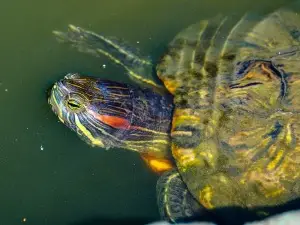
Learning about your turtle, and understanding it, will help you be a better turtle raiser, if your turtle’s skin is red on the sides, you may be wondering why.
This article looks into why your turtle’s skin is red on the sides
Table of Contents
Why is my turtle’s skin red on the sides?
Whether your pet suddenly started developing red skin on its sides, or if it has had red skin on its sides since you got it, you may be wondering what the reason behind this red skin is.
This article looks into why your turtle’s skin is red on the sides.
It’s a red-eared slider:
If your pet turtle has red skin on the sides of its head then this may simply mean that you are raising a red-eared slider.
As the name suggests, these types of pets are characterized by a red-coloured stripe behind each eye.
The “slider” part of the name comes from the fact that they are known to slide off of rocks and ledges when they are startled.
What to do:
This is quite normal for this type of turtle, you shouldn’t be worried or confused if you have a turtle that looks like this, this look is a normal characteristic of these types of turtles.
If you however notice a colour change in your pet’s skin that isn’t common for this type of turtle then you should start to worry especially if the color change comes with signs of distress in the animal.
Growth:
If your pet turtle has pink coloring on the skin then this may simply mean that the animal is growing. This can happen in all types of turtles.
If you look at the animal’s plastron you may notice that there are patches of pink skin in this area.
This is normal in your growing turtles. As the turtle grows its skin becomes thin and you can see the blood vessels underneath, this makes the skin look pink.
What to do:
This is also very normal and isn’t something to worry about many turtles will go through this pink skin phase.
You don’t have to worry about the animal if you see this, simply ensure that your pet is eating a nutrient-rich diet and its environment is optimal for its growth
As your turtle ages, its skin will harden and you won’t be able to see the blood vessels and their color through your pet’s skin.
Septicemia:
If your pet’s skin becomes red then the animal may have a condition called septicemia. This is a serious condition, it is a blood infection that can progress quickly.
It develops when bacteria get into your pet’s blood, once the infection has spread through your pet’s whole body it is referred to as septic.
One major sign of this condition is red/pink skin on the animal’s legs or neck, a pink carapace (the top of the shell), and a pink plastron (the underside of the shell).
Other signs of this condition include swollen legs, sluggishness, and a pale color on the inside of the mouth.
What to do:
While this disease is quite a serious one it can be treated if you catch and treat it early
You’d need to take your pet to the vet if you think that it is suffering from this condition. Your vet will give your pet prescription antibiotics.
If you enjoyed this article then you may also be interested in other turtle/tortoise related articles. Here are some articles that you may be interested in: Dents In Turtle Shell, Turtle Bleeding From Mouth, Turtle Shell Soft Around Edges, Deformed Turtle Shell Care, Deformed Turtle Shell, My Turtles Tail Got Bitten Off, Turtle Missing Part Of Shell, Why Is My Turtle Losing His Shell?

